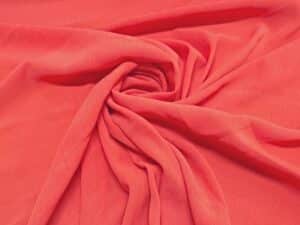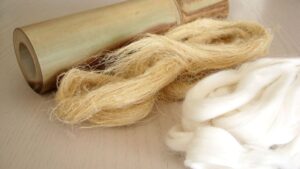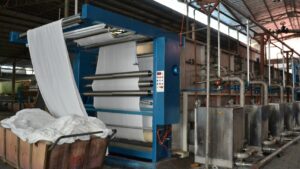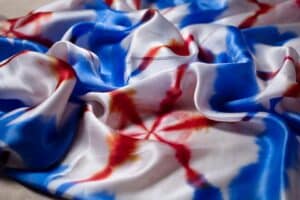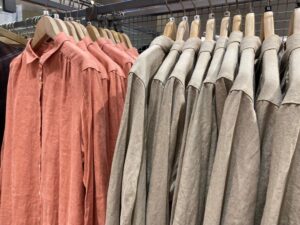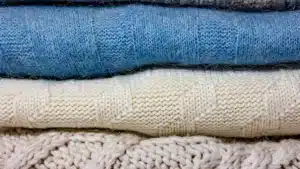
Neoprene fabric is a man-made rubber. It is flexible and strong. It can resist water, chemicals, and hot or cold temperatures. This makes it useful in many industries. Neoprene is used in wetsuits to keep people warm and comfy. It is also used in sports gear like gloves and elbow pads. This is because it is tough and keeps water out. Neoprene is also important in factories. It protects and lasts long in rough conditions. These features show how useful and versatile neoprene is.
Key Takeaways
Neoprene fabric is tough, stretchy, and resists water. It’s great for wetsuits and sports clothes.
Many industries, like healthcare and factories, use it because it lasts long and resists chemicals.
Taking care of neoprene, like rinsing and drying it, helps it last longer.
Neoprene is useful, but think about its effect on nature. Pick eco-friendly choices when you can.
Neoprene keeps heat and stretches well, making active wear comfy and better for performance.
What Is Neoprene Fabric?

Definition and Composition
Neoprene fabric is a man-made material made from rubber called polychloroprene. This rubber is made through a chemical process. The process changes chloroprene into a strong and bendable material. Neoprene is special because it resists water, keeps heat, and stretches well. These features make it useful for many things, like clothes and tools.
You may know neoprene from wetsuits. Wetsuits keep you warm in cold water. It is also used in items like phone cases and laptop covers. These protect against scratches and small bumps. Neoprene is also used in the military and factories. It is found in gaskets and machine parts.
In Chinese, we call Neoprene as 氯丁橡胶(lǜ dīng xiàng jiāo) and usually call Neoprene fabric as 潜水布(qián shuǐ bù) in fabric and clothing business. 潜水布(qián shuǐ bù) means diving fabric literally.
How Is Neoprene Fabric Made?
Making neoprene fabric starts with turning chloroprene into rubber. This is done by a process called polymerization. Here’s a simple explanation of the steps:
Chloroprene is made using chemicals like acetylene or butadiene.
Chloroprene is mixed with water, emulsifiers, and activators.
This creates polychloroprene latex, which is turned into solid chips.
Additives are added to make it stronger and stretchier.
The mixture is baked and shaped into sheets or other forms.
This process makes neoprene flexible, strong, and able to handle tough conditions.
Types of Neoprene Fabric
Neoprene fabric comes in different kinds for different uses. The two main types are:
Polychloroprene Rubber: This is the most common type. It is used in jackets, swimsuits, and shoes. It is strong and very useful.
Circular Knit Neoprene: This type is less common. It is used for special purposes.
Classification Type | Key Applications |
|---|---|
Polychloroprene Rubber | Jackets, Swimsuits, Shoes, Others |
Circular Knit | Special uses |
These types help neoprene work well in fashion and heavy-duty tools.
Key Properties of Neoprene Fabric
Physical Properties
Neoprene fabric is known for its strong and useful traits. It has a tensile strength of 8 to 17 MPa. This means it is tough and can handle pressure. It can stretch between 200% and 400%, making it very flexible. This is why it works well in wetsuits and sports gear.
Another great feature is its ability to resist water. Neoprene keeps water out, so you stay dry and comfy. It also stands up to chemicals, oil, and bad weather. This makes it last long, even in tough conditions.
Here’s a simple list of neoprene’s physical traits:
Tensile strength: 8–17 MPa
Stretchiness: 200%–400%
Water resistance: Very high
Chemical and oil resistance: Strong
Chemical Properties
Neoprene fabric is stable when exposed to chemicals. It does not break down when it touches oils or solvents. This makes it great for factories and medical tools.
It also handles extreme heat and cold well. Neoprene works in temperatures from -50°F to 275°F. This makes it perfect for wetsuits, gaskets, and safety gear.
Mechanical Properties
Neoprene fabric is tough and can handle heavy use. Its tensile strength is between 500 and 3,000 PSI(Pounds per square inch). It can stretch from 100% to 800% without breaking. This shows how strong and flexible it is.
Neoprene also resists scratches and impacts. This makes it good for machines and protective clothing. You can trust it to last a long time.
Here’s a table of neoprene’s mechanical traits:
Property | Range |
|---|---|
Tensile Strength | 500 – 3,000 PSI |
Stretchiness | 100% – 800% |
Scratch Resistance | Very Good to Excellent |
Impact Resistance | Good to Excellent |
Tear Resistance | Good to Excellent |
Bounce Back Ability | Fair to Good |
These features make neoprene a strong and flexible material for many uses.
Advantages and Disadvantages of Neoprene
Benefits of Neoprene
Neoprene fabric has many good qualities. It is very strong and lasts a long time. This makes it great for gloves, wetsuits, and covers. It can handle tough conditions without breaking easily.
Another great thing about neoprene is that it resists water, oil, and chemicals. It does not soak up water, so it keeps you dry. This is why it is used in sports and outdoor clothes. It is also safe for healthcare items like braces and supports.
Neoprene keeps heat well, making it good for cold weather. It stretches easily but stays in shape. These features make it useful for safety and tough jobs.
Many industries like cars, healthcare, and building use neoprene. It is strong and does not rust, so it protects things well. It is also used to coat and cover devices, showing how useful it is.
Drawbacks and Limitations
Neoprene has some problems too. Making neoprene uses chemicals that hurt the environment. It is also hard to recycle, which creates more waste.
Another issue is its price. Neoprene costs more than natural materials. This makes it harder for some people to afford.
Neoprene can also get weaker in sunlight. Too much sun can make it less stretchy and strong.
Knowing these problems helps you choose wisely. Neoprene has many good points, but you should think about its cost and environmental effects.
How Is Neoprene Fabric Used?

Apparel Applications
Neoprene is often used in clothes and accessories. It is found in sports bras, gym pants, and cycling pads. These items are comfy and stretch well for exercise. Designers also use neoprene in jackets, dresses, and belts. Slimming underwear made of neoprene fits tightly and keeps you warm. Its insulation makes it great for cold-weather outfits.
Neoprene bags show how useful this fabric is. These bags are light, strong, and resist water. They are great for daily use or travel. Other items like face masks, mousepads, and gadget covers also use neoprene. These protect against damage and wear. Whether for style or function, neoprene works well.

Sports and Outdoor Gear
Neoprene is important for sports and outdoor gear. It is used in wetsuits, gloves, and boots. These keep you warm and dry in water. Neoprene knee and elbow pads protect and bend easily. This makes them comfy for active movements.
The fabric does not soak up water, so it stays light. It also helps you float and keeps you warm. Neoprene stretches, letting you move freely. These features make it great for athletes and outdoor fans. Whether surfing, hiking, or biking, neoprene boosts comfort and performance.

Medical Uses
Neoprene is trusted for medical supports and therapy tools. Neoprene knee braces give support and keep heat in. This helps with knee pain and joint problems. Studies show neoprene sleeves ease pain and improve movement.
Neoprene is strong and flexible, perfect for braces and wraps. These help stabilize muscles and joints, aiding recovery. Its heat-retaining ability improves blood flow and healing. If you need reliable medical supports, neoprene is a great choice.
Industrial and Commercial Applications
Neoprene fabric is very useful in industries. It is strong and lasts long. It is used in conveyor belts, gaskets, and seals. These items face pressure, chemicals, and heat. Neoprene handles these tough conditions well. It also resists oil and water, making it reliable.
In construction, neoprene is used in bridge bearings and joints. These parts absorb shakes and let structures move safely. Neoprene’s strength and flexibility make it great for these jobs. It is also used in roofing to keep out weather and provide insulation.
The military uses neoprene for its protective features. It is found in wetsuits, safety gear, and vehicle parts. Neoprene stays strong in tough conditions. It works well in extreme heat or cold, making it dependable for military needs.
In business, neoprene is used in protective covers. You’ll see it in laptop sleeves, phone cases, and camera bags. These items benefit from neoprene’s shock-absorbing and water-resistant traits. It is also used in packaging to protect fragile items during shipping.
Neoprene is helpful in cars too. It is used in seat covers, floor mats, and engine parts. It resists heat and oil, making it perfect for vehicles. From factories to everyday items, neoprene proves its worth in many ways.
Environmental Impact of Neoprene Fabric
Making and throwing away neoprene harms the environment. Neoprene is made using chloroprene, a harmful chemical. The EPA says chloroprene might cause cancer. Factories making neoprene release harmful gases into the air. These gases can hurt people and nature nearby.
Old neoprene products create more problems. Neoprene does not break down quickly. It can stay in landfills for many years. When burned, it releases dioxins, which are very toxic. These chemicals can pollute soil and water, harming animals and people.
Some companies are trying to fix these problems. They make eco-friendly wetsuits from recycled or green materials. These new products are strong and flexible but better for the planet.
You can help by picking recycled or eco-friendly items. Buying from brands that care about the Earth pushes others to do the same. Your choices can help reduce neoprene’s harm to the environment.
Care and Maintenance of Neoprene Products
Cleaning and Storage Tips
Taking care of neoprene keeps it in good shape longer. After using it, rinse with clean water. This is important if it touched saltwater or chlorine. These can weaken neoprene over time. Use gentle soap and cold water to wash it. This keeps it stretchy and stops damage.
Dry neoprene without heat. Don’t use dryers or heaters. Air dry it in a shady spot. Sunlight can harm neoprene because of UV rays. Store items flat or hang them on wide hangers. Folding for too long can leave marks or weaken the fabric.
You can also use special conditioners for neoprene. These keep it soft and stretchy, helping it last longer.
Prolonging Product Lifespan
To make neoprene last, follow simple care steps. Keep it in a cool, dry place. Avoid sunlight and ozone sources. Heat can damage neoprene, so don’t leave it in hot cars or near heaters.
Clean neoprene often. Wash it with mild soap and water to remove dirt and oils. Use special conditioners sometimes to keep it flexible and stop brittleness.
Store neoprene properly when not in use. Hang it or lay it flat to avoid stress on the material. Following these tips will help your neoprene gear stay useful for years.
Neoprene fabric is special because of its useful features. It keeps water out and handles heat or cold well. This makes it strong and good for many uses. You can find it in sports gear, factory tools, and everyday items.
Key Features | Advantages | Common Uses |
|---|---|---|
Water Resistance | Long-lasting and Useful | Sports and Outdoor Equipment |
Heat and Cold Tolerance | Warmth and Flexibility | Industrial Tools and Daily Items |
Neoprene works well for comfort, safety, and strength. Its stretchiness and toughness make it a smart pick for many needs. Try neoprene products to see how helpful they are!
FAQ
What makes neoprene special compared to other fabrics?
Neoprene is unique because it blocks water, stretches easily, and handles hot or cold temperatures. It also lasts longer than many natural materials. These traits make it great for sports gear, tools, and protective wear.
Can neoprene items be recycled?
Recycling neoprene is hard because of its chemicals. But some companies now offer eco-friendly choices or programs to reuse old neoprene. Picking these options helps cut down on waste.
Is neoprene okay for sensitive skin?
Neoprene is usually safe, but some people may get skin irritation after long use. If your skin is sensitive, choose items with soft linings or hypoallergenic materials.
How should you clean neoprene gear?
Wash neoprene with clean water after using it, especially if it touched saltwater or chlorine. Use gentle soap and cold water for a deeper clean. Let it air dry away from heat, which can harm the fabric.
Why is neoprene loved in sportswear?
Neoprene keeps you warm, stretches well, and repels water. These features make it perfect for wetsuits, gloves, and sports gear. It also supports muscles, making activities more comfortable.


